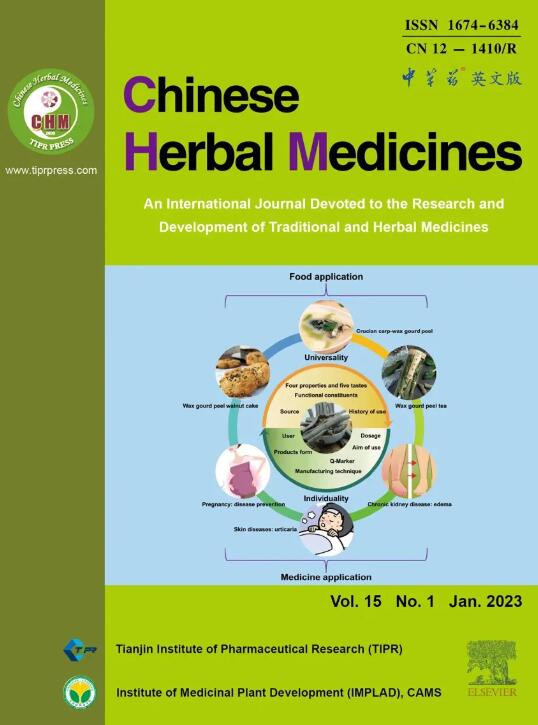Network pharmacology, molecular docking, and untargeted metabolomics reveal molecular mechanisms of multi-targets effects of Qingfei Tongluo Plaster improving respiratory syncytial virus pneumonia
IF 8.9
4区 医学
Q1 CHEMISTRY, MEDICINAL
引用次数: 0
Abstract
Objective
Qingfei Tongluo Plaster (QFP), an improved Chinese medicine hospital preparation, is an attractive treatment option due to its well clinical efficacy, convenience, economy, and patient compliance in the treatment of respiratory syncytial virus (RSV) pneumonia. The aim of this study was to investigate the efficacy mechanism of QFP on RSV rats from the perspective of alleviating lung inflammation and further explore the changes of serum metabolites and metabolic pathways in RSV rats under the influence of QFP.
Methods
This study used network pharmacological methods and molecular docking combined with molecular biology and metabolomics from multi-dimensional perspectives to screen and verify the therapeutic targets. Open online databases were used to speculate the gene targets of efficient ingredients and diseases. Then, we used the String database to examine the fundamental interaction of common targets of drugs and diseases. An online enrichment analysis was performed to predict the functional pathways. Molecular docking was applied to discover the binding modes between essential ingredients and crucial gene targets. Finally, we demonstrated the anti-inflammatory ability of QFP in the RSV-evoked pneumonia rat model and explained the mechanism in combination with the metabolomics results.
Results
There were 19 critical targets defined as the core targets: tumor necrosis factor (TNF), inducible nitric oxide synthase 2 (NOS2), mitogen-activated protein kinase 14 (MAPK14), g1/S-specific cyclin-D1 (CCND1), signal transducer and activator of transcription 1-alpha/beta (STAT1), proto-oncogene tyrosine-protein kinase Src (SRC), cellular tumor antigen p53 (TP53), interleukin-6 (IL6), hypoxia-inducible factor 1-alpha (HIF1A), RAC-alpha serine/threonine-protein kinase (AKT1), signal transducer and activator of transcription 3 (STAT3), heat shock protein HSP 90-alpha (HSP90AA1), tyrosine-protein kinase JAK2 (JAK2), cyclin-dependent kinase inhibitor 1 (CDKN1A), mitogen-activated protein kinase 3 (MAPK3), epidermal growth factor receptor (EGFR), myc proto-oncogene protein (MYC), protein c-Fos (FOS) and transcription factor p65 (RELA). QFP treated RSV pneumonia mainly through the phosphatidylinositol 3-kinase (PI3K)/RAC AKT pathway, HIF-1 pathway, IL-17 pathway, TNF pathway, and MAPK pathway. Animal experiments proved that QFP could effectively ameliorate RSV-induced pulmonary inflammation. A total of 28 metabolites underwent significant changes in the QFP treatment, and there are four metabolic pathways consistent with the KEGG pathway analyzed by network pharmacology, suggesting that they may be critical processes related to treatment.
Conclusion
These results provide essential perspicacity into the mechanisms of action of QFP as a promising anti-RSV drug.
网络药理学、分子对接和非靶向代谢组学揭示清瘟通络膏改善呼吸道合胞病毒肺炎多靶点效应的分子机制
目的清瘟通络膏(QFP)是一种改良的中药医院制剂,在治疗呼吸道合胞病毒(RSV)肺炎方面具有良好的临床疗效、方便、经济和患者依从性,是一种有吸引力的治疗选择。本研究旨在从缓解肺部炎症的角度探讨芪苈强心丸对RSV大鼠的疗效机制,并进一步探讨芪苈强心丸影响下RSV大鼠血清代谢物和代谢途径的变化。我们利用开放的在线数据库推测了高效成分和疾病的基因靶点。然后,我们利用 String 数据库研究了药物和疾病共同靶点的基本相互作用。通过在线富集分析预测功能通路。应用分子对接发现了重要成分与关键基因靶点之间的结合模式。最后,我们证明了 QFP 在 RSV 诱发的肺炎大鼠模型中的抗炎能力,并结合代谢组学结果解释了其机制。结果有 19 个关键靶点被定义为核心靶点:肿瘤坏死因子(TNF)、诱导型一氧化氮合酶 2(NOS2)、丝裂原活化蛋白激酶 14(MAPK14)、g1/S-特异性细胞周期蛋白-D1(CCND1)、信号转导因子和激活因子(MAPK14)、细胞周期蛋白-D1(CCND1)、信号转导和激活转录因子 1-α/β(STAT1)、原癌基因酪氨酸蛋白激酶 Src(SRC)、细胞肿瘤抗原 p53(TP53)、白细胞介素 6(IL6)、缺氧诱导因子 1-α(HIF1A)、RAC-α丝氨酸/苏氨酸蛋白激酶(AKT1)、转录信号转导和激活因子 3(STAT3)、热休克蛋白 HSP 90-α(HSP90AA1)、酪氨酸蛋白激酶 JAK2(JAK2)、细胞周期蛋白依赖性激酶抑制剂 1 (CDKN1A)、丝裂原活化蛋白激酶 3 (MAPK3)、表皮生长因子受体 (EGFR)、myc 原癌基因蛋白 (MYC)、c-Fos 蛋白 (FOS) 和转录因子 p65 (RELA)。QFP 主要通过磷脂酰肌醇 3- 激酶(PI3K)/RAC AKT 通路、HIF-1 通路、IL-17 通路、TNF 通路和 MAPK 通路治疗 RSV 肺炎。动物实验证明,QFP 能有效改善 RSV 引起的肺部炎症。共有 28 种代谢物在 QFP 治疗中发生了显著变化,其中有 4 条代谢通路与网络药理学分析的 KEGG 通路一致,表明它们可能是与治疗相关的关键过程。
本文章由计算机程序翻译,如有差异,请以英文原文为准。
求助全文
约1分钟内获得全文
求助全文
来源期刊

Chinese Herbal Medicines
CHEMISTRY, MEDICINAL-
CiteScore
4.40
自引率
5.30%
发文量
629
审稿时长
10 weeks
期刊介绍:
Chinese Herbal Medicines is intended to disseminate the latest developments and research progress in traditional and herbal medical sciences to researchers, practitioners, academics and administrators worldwide in the field of traditional and herbal medicines. The journal's international coverage ensures that research and progress from all regions of the world are widely included.
CHM is a core journal of Chinese science and technology. The journal entered into the ESCI database in 2017, and then was included in PMC, Scopus and other important international search systems. In 2019, CHM was successfully selected for the “China Science and Technology Journal Excellence Action Plan” project, which has markedly improved its international influence and industry popularity. CHM obtained the first impact factor of 3.8 in Journal Citation Reports (JCR) in 2023.
 求助内容:
求助内容: 应助结果提醒方式:
应助结果提醒方式:


